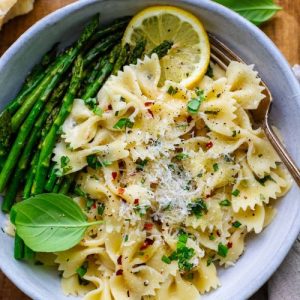
Lemon Asparagus Pasta
A light, vibrant pasta tossed with roasted asparagus, fresh herbs, and a bright lemon-parmesan sauce. Quick, healthy, and full of flavor, this dish is perfect for weeknight dinners or meal prep.
Equipment
- Large Pot (for boiling pasta)
- Sheet pan (for roasting asparagus)
- Ladle (for reserving pasta water)
- Colander (for draining pasta)
- Mixing spoon
Ingredients
- 6 oz pasta noodles any type
- 1 lb asparagus trimmed
- 3 Tbsp olive oil divided
- ⅓ cup Parmesan Reggiano freshly grated
- 2 Tbsp fresh lemon juice
- ¼ tsp lemon zest
- 3 Tbsp fresh basil chopped
- 1 Tbsp fresh oregano chopped
- ¼ tsp red pepper flakes
- ¼ tsp garlic powder
- Salt & black pepper to taste
Instructions
- Preheat the Oven for Roasting: Set your oven to 400°F (205°C) and allow it to fully preheat while you prep the ingredients. A properly heated oven ensures your asparagus will roast evenly, becoming tender but still slightly crisp, which gives a perfect bite to complement the pasta.
- Prepare the Pasta Water: Fill a large pot with water, making sure there’s enough to comfortably submerge your pasta. Add a generous pinch of salt—this is crucial for flavoring the noodles from the inside out. Place the pot over high heat and bring the water to a rolling boil.
- Trim and Season the Asparagus: While waiting for the water to boil, rinse 1 lb of fresh asparagus under cool running water. Snap off the woody ends by bending each stalk gently; they naturally break at the right point. Lay the asparagus evenly on a sheet pan, drizzle 1–2 teaspoons of olive oil over them, then sprinkle with garlic powder and a pinch of salt. Toss gently so each spear is coated.
- Roast the Asparagus: Place the prepared asparagus in the preheated oven. Roast for 10–12 minutes, flipping halfway through, until tender and slightly caramelized. This roasting process brings out a natural sweetness and adds a subtle depth of flavor to the dish.
- Cook the Pasta to Al Dente: Once the water is boiling, add 6 oz of your preferred pasta noodles. Stir occasionally to prevent sticking. Cook according to the package instructions, aiming for “al dente,” which means the pasta should be cooked but still slightly firm when bitten. Overcooking will make it mushy and less pleasant in texture.
- Reserve Pasta Water: Before draining the pasta, use a ladle to scoop out ½–¾ cup of the starchy pasta water and set it aside. This liquid will help create a silky sauce that clings to the noodles. Then, drain the pasta in a colander.
- Combine Pasta with Flavors: Return the drained pasta to the pot over low heat. Add ½ cup of the reserved pasta water (more if needed for desired consistency), 2 tablespoons of fresh lemon juice, ¼ teaspoon lemon zest, ¼ teaspoon red pepper flakes, 3 tablespoons chopped basil, 1 tablespoon chopped oregano, and the remaining 2–3 tablespoons of olive oil. Toss gently but thoroughly to coat the noodles evenly.
- Add Parmesan and Adjust Seasoning: Sprinkle in 1/3 cup freshly grated Parmesan cheese while stirring the pasta. The gentle heat of the noodles will help the cheese melt slightly, creating a creamy texture. Taste and adjust seasoning with salt and freshly cracked black pepper as needed.
- Serve with Roasted Asparagus: Transfer the pasta to serving plates or a large serving bowl. Lay the roasted asparagus spears on top or mix them into the pasta if preferred. For extra flavor and visual appeal, sprinkle additional Parmesan cheese and chopped fresh herbs on top.
- Enjoy Immediately: Serve the Lemon Asparagus Pasta while warm. Pair with a crisp green salad or a slice of crusty bread for a complete, balanced meal. This dish is best enjoyed fresh but can be stored in an airtight container in the refrigerator for up to 2 days.
Notes
- Pasta Choices: Use any pasta you prefer—farfalle, mini shells, orecchiette, rotini, or fusilli work best for holding the sauce. Gluten-free pasta options like chickpea or brown rice pasta are great alternatives.
- Asparagus Tips: Choose firm, bright green asparagus with closed tips for best flavor. Snap off the woody ends before roasting for tenderness.
- Cheese Variations: Parmesan Reggiano is ideal, but Pecorino Romano or a vegan Parmesan alternative can also be used.
- Adjusting Heat: Red pepper flakes add subtle heat; adjust the quantity based on your spice preference.
- Pasta Water Magic: Reserving pasta water is key to creating a silky sauce that evenly coats the noodles.